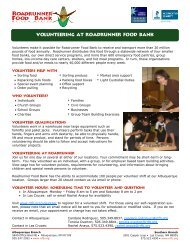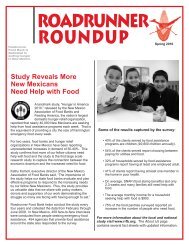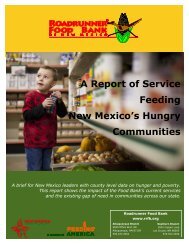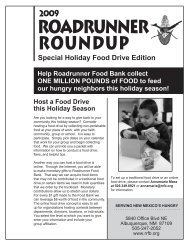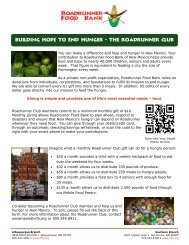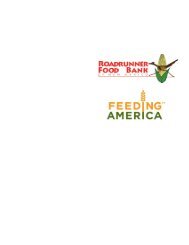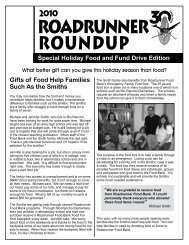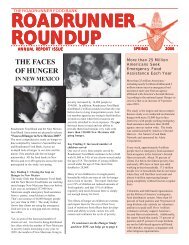Roadrunner Food Bank Annual Report
Roadrunner Food Bank Annual Report
Roadrunner Food Bank Annual Report
Create successful ePaper yourself
Turn your PDF publications into a flip-book with our unique Google optimized e-Paper software.
<strong>Roadrunner</strong> <strong>Food</strong> <strong>Bank</strong> <strong>Annual</strong> <strong>Report</strong><br />
Fiscal Year 2009 - 2010
<strong>Roadrunner</strong> <strong>Food</strong> <strong>Bank</strong> <strong>Annual</strong> <strong>Report</strong><br />
Fiscal Year 2009 - 2010<br />
The 2009-2010 fiscal year marked several milestones for <strong>Roadrunner</strong> <strong>Food</strong> <strong>Bank</strong>. Our programs changed and<br />
grew accompanied with a much-needed recent move to a larger facility allowing us to distribute more food. All<br />
of these improvements and changes help us meet the needs of the hungry people in our state. In a time of<br />
economic strife, more and more children, families, and seniors needed our help with a basic necessity…food.<br />
In fact, nearly 40,000 New Mexicans sought our help every week of last year.<br />
<strong>Roadrunner</strong> <strong>Food</strong> <strong>Bank</strong> Milestones<br />
• The first full year we were in our new home with necessary renovations completed to move forward in<br />
furthering our work<br />
• The move to a larger facility enabled us to secure and distribute 22 million pounds of food compared to 17<br />
million the year prior<br />
• Completed 3,962 food deliveries to agencies compared to 2,097, an 89% increase<br />
• Release of the 2010 Hunger Study conducted in collaboration with Feeding America and the New Mexico<br />
Association of <strong>Food</strong> <strong>Bank</strong>s<br />
• A few of the Hunger Study stats revealed that:<br />
» We serve 40,000 different people every week<br />
» More than 40% of those we serve are children<br />
» SNAP benefits (food stamps) last only about 2.3 weeks each month<br />
» More than 40% of those we serve report they have one household member in poor health<br />
» 54% of the households we serve are choosing between food and utilities<br />
» 45% of the households we serve are choosing between food and medical care<br />
• <strong>Food</strong> donors such as retailers, farmers, growers, manufactures and wholesalers contributed more<br />
than 16.2 million pounds of food this year compared to 12.4 million pounds last year<br />
• Total amount of produce we distributed was 7.3 million pounds compared to 6.5 million the year prior<br />
• First visit by a New Mexico governor to the <strong>Food</strong> <strong>Bank</strong> by Governor Bill Richardson<br />
• Received a truck donation from Walmart enabling us obtain and distribute more food<br />
• Obtained a low-interest loan from the Kresge Foundation allowing us to expand our fleet and increase our<br />
food distribution to distant communities. The Rotary Club of Albuquerque committed to raising funds to<br />
help pay down the loan for one tractor and one trailer<br />
» Two Kenworth tractors<br />
» One 53 foot trailer<br />
» One 48 foot trailer<br />
<strong>Roadrunner</strong> <strong>Food</strong> <strong>Bank</strong> <strong>Annual</strong> <strong>Report</strong> | Fiscal Year 2009 - 2010 3
Partner Agencies<br />
Most of the food that we distribute to serve the hungry is through partner agencies. Our partner agencies<br />
include food pantries, soup kitchens, shelters and other hunger relief organizations. In fiscal year 09/10, we<br />
served about 600 agencies statewide in a 10 county area, as well as through a network of five “sister” food<br />
banks in Las Cruces, Gallup, Santa Fe, Clovis and Farmington that we distribute food to. These fellow food<br />
banks in turn provide food to agencies in their communities. Through this network we are able to serve all 33<br />
counties in the state.<br />
As part of our role, we actively seek out potential agencies who would like to receive food from us. It is<br />
important for us to grow the number of our partner agencies so that we are able to expand our network to<br />
feed the growing number of hungry people in New Mexico.<br />
Partner agencies go through our monitoring process every other year, and all partner agencies and direct<br />
service programs such as our Mobile <strong>Food</strong> Pantry, <strong>Food</strong> For Kids Backpack Program, Senior Helpings Program<br />
and Emergency Family <strong>Food</strong> Box sites are required to have a bi-annual monitoring visit from us. Through our<br />
monitoring we gauge the agency cleanliness, appropriate dry good and cold food storage and general food<br />
safety practices. This process also allows us to inquire how we can provide better service to our agencies, what<br />
types of food they would like us to provide, or what types of services would they like to see from us.<br />
Key Milestones – Partner Agencies<br />
• Total number of partner agencies directly served by the <strong>Food</strong> <strong>Bank</strong>– 222 this year compared to<br />
217 last fiscal year<br />
• 47 new agencies added and 42 were inactivated<br />
• In fiscal year 2009-2010, we conducted 197 monitoring visits<br />
• Partner agencies distributed 14.4 million pounds of food compared to 9.8 million pounds of food last fiscal<br />
year which is a 47% increase<br />
Partner Agencies Touching Lives<br />
Bethel Community Storehouse is one agency that receives food from <strong>Roadrunner</strong> <strong>Food</strong> <strong>Bank</strong>.<br />
Linda Smith runs the agency and serves at its executive director. She has been doing this work for more<br />
than 22 years. And while Linda is reaching out into the Moriarty community to help vulnerable people who<br />
are hungry, you would be surprised by her own story.<br />
Linda found herself needing help with food prior to coming to the agency. She said, “My husband was in<br />
a car accident and broke his neck. We found ourselves with two children and no income. I had to swallow<br />
my pride and get up the nerve to go ask for help. They embraced me and they supported our situation. We<br />
got out of it.”<br />
She is moved to tears when she relays stories of people who have come to her food pantry that need help.<br />
One young 20 year old woman arrived and began filling out a client card, but she was shaking so badly she<br />
couldn’t keep a steady hand to fill it out. When Linda asked if she could help her, the young woman said,<br />
“Sorry, but I’m hungry I haven’t eaten.” Linda asked how long it had been since he had eaten and the<br />
young woman said, “Four days.”<br />
4
It took everything the woman had to sit in the chair and Linda and her agency quickly acted and brought<br />
her some food to eat immediately. Linda said, “Forget the paperwork, we’ll do that later.”<br />
Linda and the young 20 year old woman she helped is one of tens of thousands of stories in our state<br />
where people don’t have enough food to eat.<br />
Mobile <strong>Food</strong> Pantry<br />
The Concept – Bringing <strong>Food</strong> to Underserved Communities<br />
For the <strong>Food</strong> <strong>Bank</strong>, this program was a grand experiment proven in other places around the country, but not<br />
tried in New Mexico. From its launch in 2008, the program‘s goal was to efficiently move food in trucks to a<br />
site where food distribution could take place immediately after arrival. The benefits of this program are that<br />
anyone would have the ability to host one, such as a community member, civic groups, churches, or any group<br />
of motivated volunteers who want to help provide food to the hungry in their community.<br />
Families coming to the Mobile <strong>Food</strong> Pantry for help with food receive 50 pounds of food that includes<br />
perishable items such as dairy, meats and produce as well as quality dry goods and canned items.<br />
Mobile <strong>Food</strong> Pantry Challenges<br />
In a little more than two years, the program has almost reached its maximum capacity in our ability to continue<br />
taking on new sites. More philanthropic support will be vital to distributing additional food. Additional trucks<br />
and staff will be important for the <strong>Food</strong> <strong>Bank</strong> to grow and continue expanding the program in upcoming years.<br />
Key Milestones – Mobile <strong>Food</strong> Pantry<br />
• Distributed 2,505,200 pounds of food compared with 1,025,000 pounds of food the year before<br />
which is a 144% increase<br />
• Served 10 counties from Catron to Sandoval to Lea County<br />
• Reached people in rural communities who have difficulty accessing food assistance<br />
• The Mobile <strong>Food</strong> Pantry reaches more children than expected - 42% of clients served through the<br />
program are children<br />
• The Mobile <strong>Food</strong> Pantry distributed food 607 times over the year compared to 292 the year prior<br />
• Last year this program alone:<br />
» Drove 46,522 miles compared to 22,000 miles the year prior<br />
» Fed 52,858 households compared to 20,000 the year prior<br />
» Touched the lives of 162,901 individuals compared to 55,000 the year prior<br />
<strong>Roadrunner</strong> <strong>Food</strong> <strong>Bank</strong> <strong>Annual</strong> <strong>Report</strong> | Fiscal Year 2009 - 2010
A Gift of Hope<br />
Meadowlake is a very poor and underserved community near Los Lunas. It was one of <strong>Roadrunner</strong>’s initial<br />
Mobile <strong>Food</strong> Pantry stops where we met David.<br />
David worked as a fire fighter, but became injured on the job. When he broke his back, it left him on<br />
disability, and reliant solely on a monthly disability check. When we met David, he told us how grateful he<br />
was to receive food from our Mobile <strong>Food</strong> Pantry. David said with tears in his eyes, “God bless you for this<br />
food. It arrived just in time for me to have at least one meal today.”<br />
His food situation was grim. David said he was out of food by the 15th of every month with no additional<br />
resources to purchase groceries. What he said shocked us. He had nothing in his cabinets to eat. Not one<br />
canned food item, not one leftover from previous meals. Instead he said, “I hate to say it, but I sometimes<br />
even eat dog food. I put a little milk in it and it’s like cereal.”<br />
David is one example of the thousands of grandparents, moms, dads, children, families and siblings who<br />
have benefitted from our Mobile <strong>Food</strong> Pantry.<br />
<strong>Food</strong> For Kids<br />
Children are our future. But tens of thousands of children in our state don’t receive the adequate amount<br />
of food to grow, think, learn, and play. We expect children to perform in school by getting good grades and<br />
participating in class. But how can we expect a child who doesn’t have enough food to do that Many of<br />
our smallest and most vulnerable citizens don’t have the adequate fuel to think, learn, play, participate or be<br />
creative. <strong>Food</strong> for many of them is the one missing piece of the puzzle in ensuring their success in school.<br />
<strong>Food</strong> For Kids is a weekend backpack program that provides children food for the weekend. Nearly 10 years<br />
ago, the program was started because educators and school personnel came to us and said many of their<br />
children weren’t eating at all or too little during the weekend. On Monday when they arrived to school, kids<br />
couldn’t perform tasks because they hadn’t had enough to eat.<br />
Included in the backpack are 12 items which include proteins such as peanut butter and milk, grains such<br />
as cereal bars and packaged fruit. All items are non-perishable. This past year <strong>Food</strong> For Kids served nearly<br />
3,210 children every week during 35 weeks of the school year. Thirty-eight elementary schools in Bernalillo,<br />
Sandoval, Socorro, Torrance and Valencia counties received backpacks and food to be filled weekly by the<br />
school. However, there continues to be additional schools and children who could benefit from the program.<br />
6
In fact, 19 schools remain on the waiting list for this program that each have hungry children who don’t receive<br />
enough food to eat.<br />
This was the first year the <strong>Food</strong> <strong>Bank</strong> implemented an application process for schools. The process allowed<br />
schools to be considered for the program that may have not had the opportunity previously. The selection of<br />
the schools was based on various criteria, one of which is that a school must have a certain percentage of<br />
children that qualify for the free/reduced meal program. Schools “awarded” the program will receive it for<br />
three years. In the spring of 2013, existing schools and new schools interested in the program can apply for<br />
the next three years.<br />
<strong>Food</strong> For Kids Program Challenges<br />
Almost all the food for the program is purchased by the <strong>Food</strong> <strong>Bank</strong> annually, but as food prices continue to<br />
increase, the costs of the program continue to increase. In addition, the smaller packing necessary for the<br />
program is much more expensive than the bulk product we buy, which could in the future inhibit our ability<br />
to expand the program. Significant, additional private donations will be imperative for the growth and<br />
maintenance of the program.<br />
Key Milestones – <strong>Food</strong> for Kids<br />
• Backpacks were distributed 35 weeks of the school year<br />
• Distributed 3,210 backpacks filled with food weekly or 112,350 servings in one year<br />
• Expanded from 36 schools to 38 schools in five counties<br />
• The school with the largest number of backpacks was Edward Gonzales Elementary that distributed 200<br />
backpacks every week<br />
• Nearly 68% of the children served were students and 32% were siblings of the students who aren’t yet<br />
in kindergarten<br />
• Targeted schools where at least 80% of children qualify for free and reduced breakfast/lunch<br />
<strong>Roadrunner</strong> <strong>Food</strong> <strong>Bank</strong> <strong>Annual</strong> <strong>Report</strong> | Fiscal Year 2009 - 2010
<strong>Food</strong> is the Fuel for Success<br />
Michael is a child who has struggled in elementary school. He has struggled to perform well, struggled to<br />
fit in, struggled to be a part of his classroom activities. Why His teacher discovered that his mom worked<br />
nights leaving him usually without dinner or breakfast, and since Michael usually came late to school he<br />
didn’t have time to eat his free breakfast provided at the school. Michael’s teacher said his hunger was all<br />
that he could focus on, and it affected his ability to perform, interact, learn and play at school.<br />
But as one of the children who receives the backpack, all that was about to change. Michael’s teacher began<br />
allowing him to eat right when he entered the classroom. They let him keep his backpack in the room<br />
and made sure he ate first thing…before doing anything else.<br />
That one act, that one change of eating every morning has allowed Michael to transform. The simple gift<br />
of food has enabled him to do all the things we expect our children to do at school, and for the first time,<br />
we’ve been told he is on the way to having good grades. <strong>Food</strong> was all that he needed to succeed.<br />
Senior Helpings<br />
Our parents and grandparents may not ask us for help when they really need it. The era they grew up in made<br />
them self reliant in times of difficulty. Members of this proud generation may not always let us know when they<br />
need help…especially when they need help with food.<br />
Seniors today may have outlived their retirement or live on such a tight fixed income that they cut or limit food<br />
purchases out of their monthly budget. With many elderly on medications, they may be forced to choose<br />
medication over buying food. Seniors have said to us they make a box of macaroni and cheese last 2 or 3 days<br />
because it was the only food they had available.<br />
Senior Helpings reaches seniors who need food. While this food program is supposed to supplement what<br />
seniors can purchase at the store, many seniors have said it is the only food they receive over the month.<br />
The box contains 35 pounds of food. Along with the food box we distribute perishable items such as bread<br />
and produce.<br />
8
Key Milestones for Senior Helpings<br />
• Distributed 1,221 boxes monthly through partner agencies and low-income housing sites<br />
• Senior Helpings <strong>Food</strong> Boxes were distributed in 10 counties<br />
• Distributed more than 14,000 Senior Helpings <strong>Food</strong> Boxes over the year providing nearly 420,000 meals<br />
to hungry seniors<br />
• Program attempted to help the same seniors every month for food consistency<br />
• Program focused on helping the neediest seniors and seniors living at or below the poverty level<br />
Senior Helpings Program Challenges<br />
Seniors programs are not always top of mind for many people in our community. Seniors tend to be an age group<br />
that does not complain, or is forgotten. Our program tries to help them with one basic need…food; however, more<br />
funds and food will be needed for us to significantly increase the number of food boxes we provide. Also, as our<br />
population ages and lives longer, it is imperative to expand the number of seniors we serve monthly. In the last<br />
eight years, the number of seniors we serve through our general distribution has drastically increased from<br />
11,000 to nearly 30,000 this past year.<br />
Rita is a senior in need<br />
Rita lives in a low-income senior housing site in the northeast heights of Albuquerque. She worked her<br />
entire life and had all that life could offer. She had saved money, but a divorce in her later adult years<br />
left her without many of the funds she now needs. Much of what she did save for her retirement years is<br />
now gone. She receives Social Security, but her current monthly income isn’t enough to get through every<br />
month. When we asked about her food situation, she said, “There are days I do without or eat only one<br />
meal. That is difficult especially since I have regular medications to take and I don’t feel well taking them<br />
on an empty stomach.”<br />
Thanks to the Senior Helpings program she is now able to have a reliable source of food.<br />
<strong>Roadrunner</strong> <strong>Food</strong> <strong>Bank</strong> <strong>Annual</strong> <strong>Report</strong> | Fiscal Year 2009 - 2010
Emergency Family <strong>Food</strong> Boxes<br />
The 35-pound food box is for emergency situations. The food box is put together at the <strong>Food</strong> <strong>Bank</strong> by volunteers.<br />
It is distributed through various organizations including hospitals, first responders such as fire and police,<br />
schools, and domestic violence facilities. This box is a vital tool in helping a family during a crisis to have food<br />
for a 3-4 day period until the crisis has passed. Included in the box is a referral guide that lists partner agencies<br />
where the family can seek longer term help with food.<br />
Key Milestones for Emergency Family <strong>Food</strong> Box Program<br />
• In fiscal year 2009-2010 we distributed 857 food boxes compared to 700 boxes the previous year<br />
• The box helped 2,408 people in crisis and provided nearly 30,000 emergency meals<br />
• Those helped through the crisis needed a food box for one of the following reasons:<br />
» Health Related - 31%<br />
» Employment Related – 16%<br />
» Domestic Violence – 11%<br />
» Benefits Interruption – 10%<br />
» Homelessness – 10%<br />
» Other/Unknown – 22%<br />
Looking for Work<br />
Michael and Jennifer Smith live in Rio Rancho and have been looking for work. Michael taught one year at<br />
an area high school and was laid off last year due to budget cuts. He is still seeking employment, even if it<br />
isn’t in his chosen teaching profession. Michael said, “We can keep a roof over our head, pay some of our<br />
bills, and manage to pay for some of my insulin medication, but there isn’t always enough for food. What<br />
is left of our monthly income is about $60 for groceries for the entire month for a family of seven.”<br />
Jennifer is also looking for a job, but she is busy raising her five children whose ages are from elementary<br />
school to college. She said, “It is difficult to find employment right now. The economy has made it tough<br />
to locate even a part-time job.”<br />
Even though the family has access to some unemployment and is on SNAP (food stamp) benefits, it isn’t<br />
enough for all their food needs. The family receives a <strong>Roadrunner</strong> Emergency Family <strong>Food</strong> Box through Rio<br />
Rancho Elementary to help supplement their food. Michael said, “We are so grateful to receive food from<br />
<strong>Roadrunner</strong> <strong>Food</strong> <strong>Bank</strong>. If I could personally thank everyone who donated the food items in the box,<br />
I would.”<br />
<strong>Roadrunner</strong> <strong>Food</strong> <strong>Bank</strong> <strong>Annual</strong> <strong>Report</strong> | Fiscal Year 2009 - 2010 11
Volunteers<br />
Volunteers are very important in helping us in our mission to end hunger. Without the support of volunteers we<br />
would be unable to distribute as much food every year as we do. They are the base of support that helps us<br />
make it a reality for hungry people to have food.<br />
Volunteers help us repack bulk food items and place them into smaller single serving or family serving sized<br />
packaging. Volunteers also help us sort food including canned items, dry good items and perishable items we<br />
receive from donors. By sorting the food, we know exactly what types of food we have received as donations.<br />
Otherwise we would have no idea how many and what types of various products we have on hand for our<br />
agencies to take.<br />
Through their support volunteers also help fill our Emergency Family <strong>Food</strong> Boxes and our Senior Helpings<br />
Boxes. These food boxes are crucial for seniors who do not have enough food or people in crisis who need<br />
temporary food relief.<br />
Families, individuals, groups and businesses have all come to the <strong>Food</strong> <strong>Bank</strong> to help us. We have some<br />
volunteers who come once and others who come back every single day or every week. Thanks to the service<br />
of volunteers to our hungry community, we are able to continue increasing our food distribution by increasing<br />
the number of pounds we can distribute every year.<br />
Thank you to all of those who come to help us whether it is one time or many. Your support extends a helping<br />
hand to so many people that you may never meet. Thank you for your service!<br />
Volunteers 2009-2010<br />
Total volunteer hours: 62,741<br />
Total number of volunteers: 22,278<br />
Unduplicated number of volunteers: 9,362<br />
Volunteers 2008-2009<br />
Total volunteer hours: 36,011<br />
Total number of volunteers: 14,625<br />
Unduplicated number of volunteers: 8,111<br />
Key Milestones for Volunteers<br />
• Number of service hours increased 75% over last year<br />
• The number of hours volunteers gave to the <strong>Food</strong> <strong>Bank</strong> equals the work of 31 full-time employees<br />
• The total number of volunteers went up 52% from last year<br />
• The number of unduplicated volunteers increased 15% from last year.<br />
12
Donors<br />
So many people in our community take that extra step to write a check or go online and make a monetary<br />
donation to support the work of the <strong>Food</strong> <strong>Bank</strong>. This generous act allows us to respond to the increasing<br />
number of our hungry neighbors, more of whom are vulnerable children, seniors and families. In fact, gifts<br />
by donors allow us to stretch our precious resources. For every $1 gift made to the <strong>Food</strong> <strong>Bank</strong>, we are able<br />
to leverage $9 worth of food for the community.<br />
You may be one of those people who have taken that extra step as our partners in helping feed the hungry,<br />
and we thank you. Your generosity will impact thousands of our hungry neighbors and give them the ability to<br />
change their life and the lives of their family members for the better.<br />
Thank you to all the donors of the <strong>Food</strong> <strong>Bank</strong>.<br />
<strong>Roadrunner</strong> <strong>Food</strong> <strong>Bank</strong> <strong>Annual</strong> <strong>Report</strong> | Fiscal Year 2009 - 2010
Giving Societies<br />
Full Plate Society<br />
The Full Plate Society is a leadership circle of donors who make a minimum pledge to the <strong>Food</strong> <strong>Bank</strong> of $1,000<br />
each year for five years. Donors in the Society give monthly, quarterly or annually. For more information about<br />
the Full Plate Society contact Stephanie Miller at stephanie@rrfb.org or call 505.349.8678.<br />
In fiscal year 2009-2010, there were 189 Full Plate Society members.<br />
<strong>Roadrunner</strong> Club<br />
The <strong>Roadrunner</strong> Club is a monthly giving club where donors select an amount over $10 a month to contribute.<br />
Monthly giving allows us to plan ahead and respond when food is needed. For more information about the<br />
<strong>Roadrunner</strong> Club contact Annamarie Maez at annamarie@rrfb.org or 505.349.8921.<br />
In fiscal year 2009-2010, there were 382 <strong>Roadrunner</strong> Club members.<br />
Memorial and HonorARY Gifts<br />
Memorial and Honorary gifts provide a wonderful way to pay tribute to the special people in your life.<br />
Whether these are family, friends, faculty, employees or colleagues. These special gifts provide an<br />
opportunity to remember, honor or recognize people you care about.<br />
Memorial gifts are a special way to commemorate the life of a friend or relative who has passed. A gift made<br />
in honor of someone celebrates unique accomplishments, special occasions like birthdays, anniversaries and<br />
weddings or simply as a way to recognize someone.<br />
Notification of the gift is sent via a card to the honoree or to the family of the person being memorialized.<br />
If you would like to honor or memorialize someone, call 349-5326.<br />
The Cornucopia Society – a Planned Giving Program<br />
The Cornucopia Society was created to recognize donors who have communicated to us that they are<br />
leaving the <strong>Food</strong> <strong>Bank</strong> in their will, trust or other planned giving instrument. A legacy gift will ensure<br />
<strong>Roadrunner</strong> <strong>Food</strong> <strong>Bank</strong> has the appropriate facilities, trucks, tractor trailers and distribution capabilities<br />
to respond to New Mexico’s hungry by providing food. <strong>Roadrunner</strong> <strong>Food</strong> <strong>Bank</strong> would be honored to be<br />
named in your will, trust or other type of deferred gift so we may continue our important work into the future.<br />
For more information, or to let us know of your planned giving intentions, please contact Andrea Bromberg<br />
at 505.349.8929 or andrea@rrfb.org<br />
<strong>Roadrunner</strong> <strong>Food</strong> <strong>Bank</strong> <strong>Annual</strong> <strong>Report</strong> | Fiscal Year 2009 - 2010 15
Holiday Gift Cards<br />
During the holiday season, <strong>Roadrunner</strong> <strong>Food</strong> <strong>Bank</strong> creates a way for community members to purchase a gift<br />
card as a holiday gift for a recipient.<br />
Recipients receive a beautiful holiday card designed by a child in one of our 38 <strong>Food</strong> for Kids schools. Inside<br />
the card is a gift tag. Different giving amounts are available and each tag includes a separate message about<br />
the type of food needs and programs at the <strong>Food</strong> <strong>Bank</strong> including food filled backpacks for hungry children,<br />
produce, emergency food boxes, senior food boxes and our Mobile <strong>Food</strong> Pantry.<br />
The Holiday Gift Card program is an easy gift to buy to recognize employees, friends, and loved ones while<br />
helping our hungry neighbors. To obtain one, simple visit our website in the fall/winter months or call us to<br />
place an order. The Holiday Gift Card program is offered to community members in late October through the<br />
New Year. For more information call 349.8921.<br />
<strong>Food</strong> Donors<br />
Manufacturers, wholesalers, distributors, supermarkets, growers and community members provide regular<br />
food donations to <strong>Roadrunner</strong> <strong>Food</strong> <strong>Bank</strong>. Without these generous food donations our <strong>Food</strong> <strong>Bank</strong> would have<br />
significantly less food to provide to the hungry people of New Mexico. Thank you to all our food donors. Your<br />
generosity helps put meals on hungry New Mexicans’ tables.<br />
Below is a list of our top food contributors.<br />
More Than One Million Pounds of <strong>Food</strong><br />
Holiday <strong>Food</strong> Drive Donors<br />
Walmart Distribution Center<br />
Walmart Stores<br />
500,000 – 1 Million Pounds<br />
Sam’s Club Holiday <strong>Food</strong> Drive<br />
Smith’s <strong>Food</strong> and Drug Stores<br />
300,000-500,000 Pounds of <strong>Food</strong><br />
Shamrock <strong>Food</strong>s<br />
Sysco<br />
100,000-300,000 Pounds of <strong>Food</strong><br />
Border <strong>Food</strong>s<br />
Core-Mark<br />
Hostess Brands<br />
National Association of Letter Carriers Branch 504<br />
Navajo Agricultural Products Industry<br />
Pueblo Fruits<br />
Rural Letter Carriers’ Association<br />
Target<br />
Trader Joe’s<br />
United States Postal Service<br />
16
ROADRUNNER FOOD BANK BOARD OF DIRECTORS 2009-2010<br />
PERRY BENDICKSEN, Chairman<br />
Brownstein Hyatt Farber Schreck LLC.<br />
JOHN DEGRAAUW, Vice Chairman<br />
Wells Fargo <strong>Bank</strong><br />
STEVE CIEPIELA, Treasurer<br />
Charles Stephen and Company, Inc.<br />
BARBARA ALLENDER<br />
Community Volunteer<br />
Cathy Brown<br />
Clifton Gunderson, LLP<br />
BECKY BURWINKLE<br />
<strong>Bank</strong> of America<br />
Frank Fine<br />
Fine Consulting Group, LLC/Liebers luggage<br />
CAROL GRAEBNER<br />
PNM Resources<br />
SID GUTIERREZ<br />
Sandia National Laboratories<br />
Janice Lucero<br />
MVD Express<br />
NATASHA MARTELL<br />
Intel Corporation<br />
CAROL RICKERT ASBURY<br />
Carol Rickert and Associates<br />
ROBERT M. SCOTT<br />
Halloween Spirit Super Stores<br />
EUGENE F. SUN, M.D., M.B.A., Secretary<br />
Molina Healthcare of New Mexico<br />
ALFONSO TRUJILLO<br />
Molina Healthcare<br />
LINDA WEDEEN<br />
Hewlett Packard Company<br />
<strong>Roadrunner</strong> <strong>Food</strong> <strong>Bank</strong> <strong>Annual</strong> <strong>Report</strong> | Fiscal Year 2009 - 2010
Statements of financial position<br />
Income Statement<br />
Fiscal Year Ending June 30, 2010<br />
Notes: The income statement indicates how revenue is transformed into net income (the result after all revenues and expenses have been accounted for, also known as<br />
the “bottom line”). It displays the revenues recognized for a specific period, and the cost and expenses charged against those revenues.<br />
Revenue<br />
Donated <strong>Food</strong> $34,299,955<br />
Contributions, Grants, and Contracts $5,434,542<br />
Program Services $1,802,547<br />
Special Events $218,037<br />
Gain on Sale of Building $0<br />
Other $128,337<br />
Total Revenue $41,883,418<br />
Expenses<br />
Program Services $39,155,795<br />
Administration $916,720<br />
Fundraising $809,486<br />
Total Expenditures $40,882,001<br />
Net gain/(loss) $1,001,417<br />
Balance Sheet<br />
Fiscal Year Ending June 30, 2010<br />
Notes: The balance sheet gives a snapshot of the financial health of an organization at a particular point in time. An organization’s total assets should generally<br />
exceed its total liabilities. The types of assets and liabilities must also be considered. For instance, an organization’s current assets (cash, receivables, securities,<br />
etc.) should be sufficient to cover its current liabilities (payables, deferred revenue, current year loan and note payments).<br />
ASSETS June 30, 2010<br />
Cash & Equivalent $1,116,652<br />
Investments/Securities $632,295<br />
Accounts Receivable $274,519<br />
Pledges & Grants Receivable $902,600<br />
Restricted Contributions $479,713<br />
In-Kind Lease Receivable $648,150<br />
Deposits $550,000<br />
Inventories for Sale or Use $2,740,057<br />
Fixed Assets $2,525,871<br />
Total ASSETS $9,869,857<br />
LIABILITIES June 30, 2010<br />
Accounts Payable & Accrued Expenses $318,517<br />
Deferred Revenue $9,817<br />
Loans and Notes $421,501<br />
Tenant Improvement Allowance $625,000<br />
Capital Lease Obligation $83,887<br />
Total LIABILITIES $1,458,722<br />
Fund BALANCE $8,411,135<br />
Comments: The vast majority of <strong>Food</strong> <strong>Bank</strong> funds are spent in acquiring, storing, transporting and distributing food. Over 95% of all expenditures (cash & in-kind) are used<br />
in the direct delivery of our core services. <strong>Roadrunner</strong> <strong>Food</strong> <strong>Bank</strong>’s last audit, dated June 30, 2010, had no findings deemed significant enough for a management letter.<br />
<strong>Roadrunner</strong> <strong>Food</strong> <strong>Bank</strong> <strong>Annual</strong> <strong>Report</strong> | Fiscal Year 2009 - 2010 19
5840 Office Blvd NE<br />
Albuquerque, NM 87109<br />
www.rrfb.org<br />
505-247-2052



